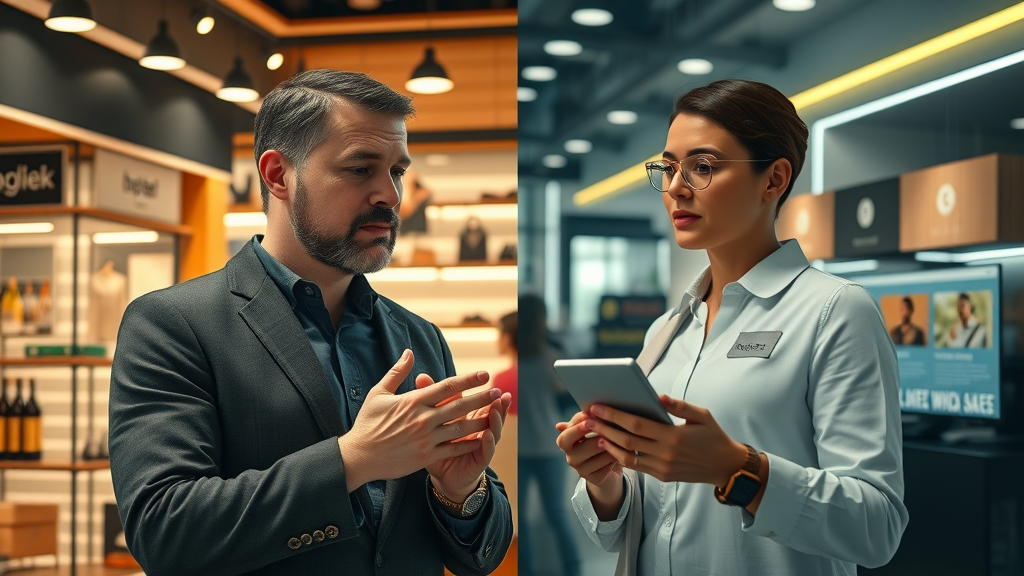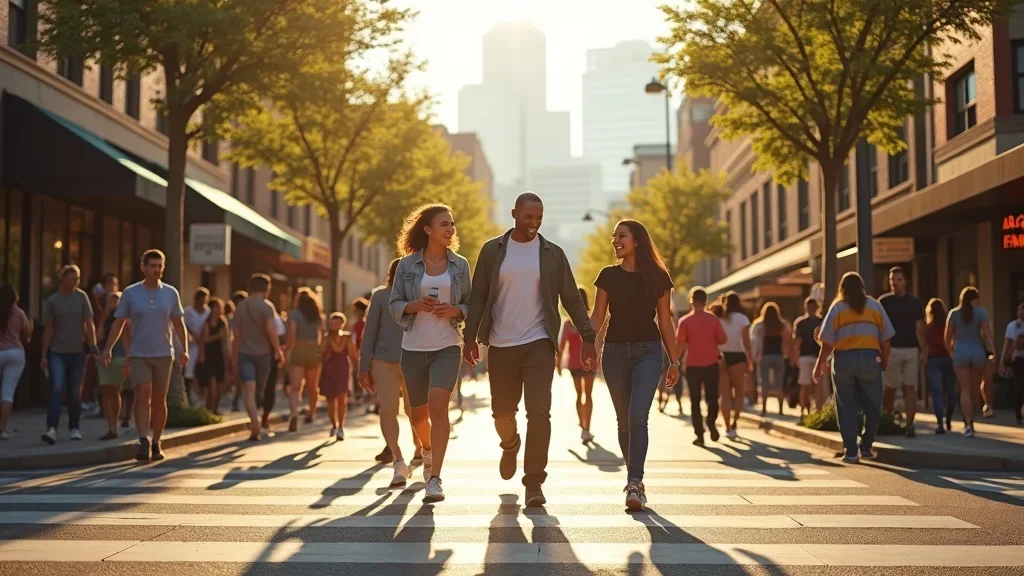Did you know that in 2023, e-commerce accounted for over 20% of global retail sales? This explosive growth has reshaped the modern business landscape, placing small businesses and physical retail stores in the crosshairs of online retail giants like Amazon and other major online stores. For business owners and managers, adapting and finding ways to compete with online retailers is not just a tactical decision—it's crucial for long-term survival. But here’s the surprising truth: your brand’s story is your greatest competitive advantage. Dive in to learn how to leverage what makes your retail business unique and turn the tide against the dominance of online shopping.

Why Learning How to Compete with Online Retailers is More Vital Than Ever
In recent years, online retail has swiftly transformed consumer behavior and the competitive landscape for every mortar store , retail store, and small business. As online stores claim a growing market share , the urgency to compete with online retailers intensifies for physical store owners everywhere. Whether you run a neighborhood shop or manage a network of mortar stores, your response to this challenge will define your future profitability and relevance in the community.
While online shopping offers vast choices and the irresistible convenience of same-day delivery , physical stores possess advantages that e-commerce cannot replicate: personalized customer service, genuine community connections, and the tangible experience of browsing and buying in person. Understanding how to leverage these strengths—and integrate new digital strategies—is essential. As we'll see, a proactive approach to competition does more than just keep your business afloat. It positions your brand as a local leader, valued by customers looking for both quality and authenticity in a noisy digital world.
Startling Realities: The Unstoppable Rise of Online Retail
"In 2023, e-commerce sales made up over 20% of global retail, reshaping the modern business landscape."
The continued surge in online retail sales isn’t a blip; it’s the new norm that’s rewriting the rules for retail business. Giants like Amazon and other retail giants invest heavily in digital marketing and logistics, making it easier than ever for customers to shop from their smartphones or laptops. As a result, store owners now face an uphill battle, fighting for foot traffic and visibility while navigating the evolving world of online competition.
Despite these challenges, brick-and-mortar retail is far from obsolete. Small businesses, local shops, and niche physical stores are proving they can thrive by focusing on local market strengths, storytelling, and the genuine customer experience that draws shoppers to their doors. The key lies in understanding these realities and responding with agility and creativity.

What You’ll Gain: Master How to Compete with Online Retailers – Key Outcomes for Business Owners and Managers
- Learn how to position your physical store to compete with online retailers
- Understand effective customer service and loyalty-building strategies
- Discover actionable ways to leverage your business story and local roots
- Implement winning omni-channel tactics and use social media to your advantage
Defining the Battle: How to Compete with Online Retailers in a Digital Age
To compete with online retailers, you first need to understand the unique dynamics between online stores and the traditional mortar store . While an online shop can reach millions instantly and operate around the clock, it often lacks the ability to form real, lasting relationships with local customers. By contrast, the advantage of a physical retail business lies in community engagement, hands-on experiences, and meaningful customer service . Recognizing these trade-offs helps every business owner design a strategy that blends the best of both worlds.
In today’s retail landscape, the challenge isn't simply about product availability or price—it's about delivering an exceptional experience that keeps customers coming back. By evaluating both your strengths and the evolving needs of your market, you can position your store as a one-of-a-kind destination, not just for products, but for connection and value.
Understanding Online Retail, Online Stores, and Traditional Mortar Stores
Let’s break down the defining characteristics, strengths, and weaknesses of the two dominant retail models. By understanding where each excels—and where each falls short—you’ll have the insights needed to find your edge and compete with online retail .
| Business Type | Strengths | Weaknesses |
|---|---|---|
| Online Retailers | Convenience, broad reach | Low personal connection |
| Physical Store (Mortar Store) | Personal experience, community connection | Limited hours, higher overhead |
Why Your Story is Your Most Powerful Tool in Competing with Online Retailers
In the digital marketplace, your story is the differentiator that helps small businesses, local markets, and brick-and-mortar retailers stand out from a generic online shop. Not only does a compelling narrative build customer trust and credibility, but it also forges deeper emotional connections that online retailers simply can’t replicate. This is why more retail businesses are focusing their branding and marketing efforts on their history, mission, and local values to outshine e-commerce competitors.
When customers hear the story behind your products, your team, and your commitment to the community, they become invested in your success. This kind of authentic bond inspires advocacy and loyalty—the two factors that reliably drive repeat business and positive word-of-mouth, even as the convenience of online shopping continues to lure casual buyers.
From Generic Online Shop to Unique Retail Business: The Power of Narrative
"Customers come for products, but they stay—and advocate—because of your story."
Unlike faceless online shops where every transaction feels impersonal, local retail businesses and mortar stores exist within a specific context—a neighborhood, a community, a network of real people. By sharing the ‘why’ behind your business, you humanize the shopping experience. Stories about your origins, your challenges, and your customer successes turn first-time buyers into loyal advocates and position your store as an integral part of the local market.
Use your narrative in every touchpoint: on your website, through social media, at your storefront, or in community outreach. Whether you’re promoting a new product or hosting an event, storytelling drives connection and gives your customers compelling reasons to choose your store over an online retailer—even if prices aren’t always lower or delivery isn’t as fast.
How to Compete with Online Retailers: Proven Strategies for Local and Small Business Success
Practical, actionable strategies are the secret weapon for any physical store or small business looking to match the convenience of online shopping while maximizing their unique strengths. Here are the building blocks for long-term success and customer loyalty—inspired by retail businesses thriving in today’s competitive environment.
Delivering Exceptional Customer Service Competitive with Online Retailers
- Personal bonds and tailored experiences
- Leveraging expertise and trust
The personal interaction that happens in mortar stores is unmatched by online retailers. By focusing on tailored assistance, memory of preferences, and genuine relationship-building, you can deliver a level of customer service that makes choosing your store a lifestyle choice—not just a transaction. In fact, personalized product recommendations, special attention to returning customers, and resolving concerns in real time create a memorable shopping experience that even the most advanced online shop can’t imitate.
Furthermore, the expertise housed in a local business—especially when staff are passionate and knowledgeable—instills trust and reliability. For a consumer overwhelmed by online choices, being able to consult a friendly face who understands the local market is invaluable. As a result, your store becomes the go-to destination for advice and inspiration, not just goods.
Enhancing In-Store Experience: Turning Mortar Stores into Destinations
- Incorporating technology that complements the physical store
- Exclusive in-person events and workshops
Rethink your mortar store as an experience hub, not just a place to buy things. This means integrating interactive displays, using digital kiosks or QR codes for product info, and curating events that encourage social interaction and learning. In-store workshops, product launches, and community gatherings give people a reason to visit, stay, and engage, cultivating deeper loyalty and maximizing word-of-mouth marketing.
Technology doesn’t have to be intimidating. By adopting innovations like mobile checkouts, online reservation systems, or interactive digital touchpoints, you can blend the strengths of online stores with the intimacy of a physical store. This fusion boosts both convenience and immersion, turning every visit into an exceptional experience .

Utilizing Social Media and Omni-Channel Strategies to Compete with Online Retail
- Targeted local campaigns and community storytelling
- Seamless customer journey across all channels
Social media provides every retail business with a platform to reach and engage local customers in real time. By sharing behind-the-scenes stories, celebrating milestones, spotlighting customer testimonials, and running exclusive online contests, small businesses can expand their reach far beyond their existing customer base. These efforts personalize your online presence, invite two-way conversations, and visually reinforce your brand’s narrative.
Omni-channel strategies—combining physical and online experiences—make shopping seamless. Think: allowing customers to reserve online and pick up in store, offering local delivery options, and tying brick-and-mortar loyalty programs with digital promotions. By breaking down the barriers between your online store, physical store, and digital marketing efforts, you not only compete with online retailers, but can actually outshine them with human-centered, community-focused service.
Compete with Online Retailers Through Customer Loyalty and Community Engagement
Customer loyalty isn’t a reward, it’s an outcome—a testament to the value your retail store delivers every day. While online shopping offers speed and scale, physical stores are where emotional bonds are forged. Small gestures like thank-you notes, local partnerships, and hosting community events help you build a tribe that not only returns, but refers friends and family.
Community engagement takes your business beyond transactions. Sponsoring local projects, joining neighborhood councils, or simply highlighting local causes on your social media makes your store indispensable to the people around you. A tight-knit community will help ensure you outlast online competition, even as consumer preferences shift toward e-commerce.
Building Lasting Customer Loyalty in a World of Instant Online Shopping
- Personalized loyalty programs linked to local values
- Exclusive offers and VIP experiences
A well-designed loyalty program is one of the most effective ways to compete with online retailers —but the best ones aren’t just about discounts. Tie rewards to occasions that matter within your local market , offer members-only events, and recognize customer loyalty milestones. VIP experiences, birthday surprises, and unique gifts turn routine shopping into personal celebration.
By focusing on what matters to your community—including supporting local creators and causes—you transform customers into champions for your brand. This kind of emotional reciprocity is what keeps loyal shoppers returning, even in a world obsessed with same-day delivery and instant access from massive online competitors.
Activating Your Local Market: Turning Local Customers into Advocates
"The more you connect with your community, the harder it is for online stores to steal your customers."
Activating your local market doesn’t just mean engaging customers once in a while; it’s about creating a sustained, meaningful presence in people’s lives. Support local events, feature local artists or producers in your store, and use your social media not just to advertise, but to celebrate your neighborhood. These actions create emotional investments that go far deeper than economic transactions.
True advocacy is built on shared values and ongoing participation. By putting community at the center of your business story , you’ll inspire your customers to become vocal promoters, amplifying your competitive edge and defending your business from the disruptive influence of online retailers.
Case in Point: Examples of Physical Stores Outperforming Online Competition
The proof is in real-world success stories. Across industries, small businesses and mortar stores are overcoming the odds by focusing on exceptional customer service , unforgettable experiences, and meaningful storytelling.
Stories from Retail Businesses Who Chose to Compete with Online Retail and Won
- Neighborhood bookstores driving loyalty through events
- Local cafes succeeding via social media story-driven marketing
One urban bookstore, for example, took on giants like Amazon by transforming its space into a cultural hub—hosting author signings, poetry nights, and children’s readings. Customers didn’t just come for books; they came for connection and community, leading to record-breaking repeat business and glowing local media coverage.
Similarly, a small café leveraged the power of social media and visual storytelling to create a passionate following. By consistently showcasing their local collaborations and celebrating customer milestones, they not only survived but flourished during times when online ordering was the default for so many. Real, compelling narratives convert casual visitors into loyal brand ambassadors.
Turning Weaknesses into Strengths: How Small Business Owners Can Compete with Online Retailers
While it's true that online retailers offer broad selection and convenience, small business owners can leverage what e-commerce struggles to deliver: instant satisfaction and genuine human interaction. The key is transforming perceived weaknesses—like limited inventory or shorter hours—into strengths that reinforce your value proposition and deepen customer loyalty.
Use your agility and proximity to your advantage. A physical store can turn a query or a concern into a memorable experience through empathy, expertise, and immediate solutions. These qualities foster the kind of word-of-mouth that builds staying power and keeps your market share secure.
Using Physical Store Advantages to Outshine Online Retailers
- Immediate product access and same-day fulfillment
- Human touch and emotional connection
One of the biggest advantages of a mortar store is providing instant gratification—shoppers can pick up what they need immediately, examine quality firsthand, and ask questions on the spot. Even the most sophisticated online shop cannot deliver the palpable joy of finding and owning something in real time.
Combine this with staff who know regulars by name, who understand particular preferences, and who deliver a warm, welcoming atmosphere. These human qualities not only outshine automated online shopping but create an emotional moat that’s tough for retail giants to cross. Customer service with a human face is the ultimate differentiator for independent retailers.

Future-Proofing: Evolving Mortar Stores to Compete with Online Stores Long Term
Adapting to new technologies and shifting consumer expectations is essential for securing the future of your retail business. By embracing tools that support both digital convenience and in-person connection, small business owners keep their offers competitive even as e-commerce continues to innovate.
Data-driven personalization empowers you to anticipate customer needs, optimize inventory, and tailor your customer service . Tech doesn’t have to be overwhelming; start with accessible solutions like online ordering, click-and-collect, and basic customer relationship management (CRM) platforms to bridge the gap between your online presence and your physical store.
Leveraging Technology and Data as a Mortar Store Business Owner
- Implementing click-and-collect and online ordering
- Personalization through CRM and local insights
Adopting click-and-collect models—or allowing customers to buy online and pick up at your store—adds convenience that mirrors the advantages of online shopping, without losing the benefits of face-to-face interaction. Syncing inventory and order systems reduces disappointment, encourages cross-selling, and attracts busy shoppers who still crave the certainty and immediacy only your store can provide.
Meanwhile, using a smart CRM allows you to segment your audience, customize communications, and track buying behaviors. Harnessing data this way deepens your understanding of both loyal and occasional shoppers, letting you create offers, events, and products that hit home. In the battle to compete with online retail , local insights beat automation every time.

People Also Ask: How to Compete with Online Retailers – Essential Answers
How can brick-and-mortar stores compete with online retailers?
- Focus on unique in-person experiences, community ties, and responsive customer service
- Build loyalty programs
- Leverage local knowledge and personalized offerings
Brick-and-mortar stores excel when they emphasize personal customer relationships, a deep understanding of the local market, and responsive service that online competitors struggle to match. Building loyalty programs and showcasing exclusive in-store events or products can further create a differentiated customer experience, encouraging shoppers to return and recommend your mortar store to friends and family.
How to compete against Amazon?
- Differentiation with exclusive products or services
- Outperform with hyper-local, rapid service
- Authenticity and brand storytelling
The secret to competing with Amazon lies in providing things they can’t replicate: hyper-local expertise, exclusive or locally-made products, and a business narrative rooted in authenticity and community. By being nimble, delivering faster local service (sometimes even same-day delivery on select items), and focusing your story, you give customers compelling reasons to choose you over any retail giant.
How are retail stores reacting to online competitors?
- Adopting omni-channel services
- Hosting local events and experiences
- Investing in social media and customer engagement
Retail stores are navigating online competition by merging their digital and physical customer experiences—embracing omnichannel shopping, integrating online inventory lookups, and offering services like curbside pickup. They’re also hosting local events, building strong social media communities, and using digital marketing to keep their audience engaged and informed like never before.

What is the biggest problem with online shopping?
- Lack of personal interaction
- No instant product access
- Trust concerns in unfamiliar online stores
Online shopping, despite its convenience, can feel impersonal and detached. Customers often have to wait for day delivery or longer, missing out on the immediate gratification and expert guidance of a physical retail environment. Additionally, dubious online stores or unfamiliar sellers may make customers wary about payment security and product authenticity.
Expert Insights: Rise Above the Online Competition with These Key Takeaways
- Your business story and local focus are irreplaceable assets
- Blending technology and personal connection is the new competitive edge
- Customer loyalty is earned—not bought—through experience and involvement
Frequently Asked Questions About How to Compete with Online Retailers
- How can a small business use its story to win local customers?
- What technologies should mortar stores adopt to keep up?
- How do you measure customer loyalty success offline?
Standing Out Among Online Retailers: A Roadmap to Sustainable Success
- Embrace your authentic story
- Prioritize customer engagement at every touchpoint
- Combine online reach with physical connection
Take Action: Start Transforming Your Mortar Store to Compete with Online Retailers Today
- Implement one story-driven customer engagement tactic this week
- Audit your social media presence for authenticity
- Begin tracking customer loyalty metrics now
Conclusion: Take advantage of your unique story, blend technology with personal touch, and actively engage your community to compete and win against online retailers.
Sources
- https://www.statista.com/topics/871/online-shopping/ – Statista
- https://www.nrf.com/blog/brick-and-mortar-retail-heres-why-it-matters – National Retail Federation
- https://hbr.org/2021/04/how-brick-and-mortar-retailers-can-thrive-in-a-digital-world – Harvard Business Review
- https://www.forbes.com/sites/theyec/2022/09/13/the-future-of-retail-brick-and-mortar/ – Forbes
To effectively compete with online retailers, it’s essential to leverage your unique strengths as a physical store. By focusing on personalized customer service, creating distinctive in-store experiences, and integrating technology, you can offer value that online competitors cannot match.
1. Deliver Exceptional Customer Service
Personalized service is a significant advantage for brick-and-mortar stores. By engaging with customers on a personal level, remembering their preferences, and providing tailored recommendations, you can build strong relationships that foster loyalty. This human touch creates an emotional connection that online retailers often lack. ( progressivegrocer.com )
2. Enhance the In-Store Experience
Transform your store into a destination by offering unique experiences that engage all five senses. Utilize signature scents, curated music playlists, and interactive product displays to create an inviting atmosphere. Hosting exclusive events, workshops, or product demonstrations can also draw customers in and encourage repeat visits. ( fultonbank.com )
3. Integrate Technology
Incorporate technology to streamline operations and enhance the customer experience. Implementing features like mobile checkouts, interactive kiosks, and augmented reality can make shopping more convenient and engaging. For example, H&M uses interactive touchscreens to allow customers to browse collections and access additional product information, while mobile checkout options offer flexibility. ( progressivegrocer.com )
4. Leverage First-Party Data for Personalization
Utilize customer data to deliver personalized content and offers. By analyzing purchase history, browsing behavior, and preferences, you can tailor marketing efforts to individual customers, increasing engagement and sales. Implementing a Customer Data Platform (CDP) can help consolidate and analyze this data effectively. ( bazaarvoice.com )
5. Implement Loyalty Programs
Develop loyalty programs that reward repeat customers with discounts, exclusive offers, or early access to new products. Such programs can increase customer retention and encourage repeat business. For instance, companies that excel at personalization often see higher revenue than those that don’t. ( bazaarvoice.com )
6. Offer Unique Products and Services
Differentiate your store by offering products that are not readily available online. This could include locally sourced items, exclusive collaborations, or personalized services. Highlighting the uniqueness and quality of your offerings can attract customers seeking something special. ( ecommercewithpenny.com )
7. Engage with the Community
Build strong ties with your local community by participating in events, supporting local causes, and collaborating with other businesses. This involvement not only enhances your brand’s reputation but also fosters a loyal customer base that values community engagement. ( fultonbank.com )
By focusing on these strategies, you can create a compelling shopping experience that emphasizes the strengths of your physical store, setting you apart from online competitors.
 Add Row
Add Row  Add
Add 



Write A Comment